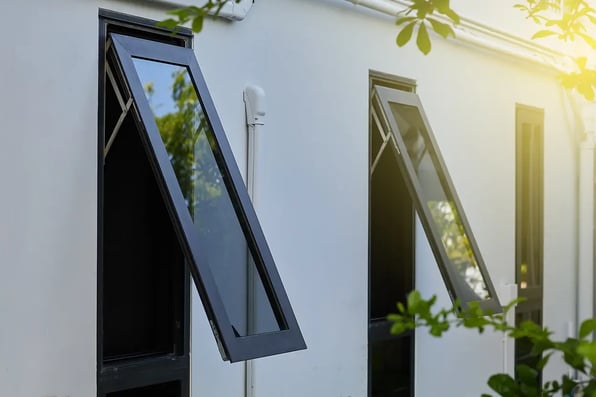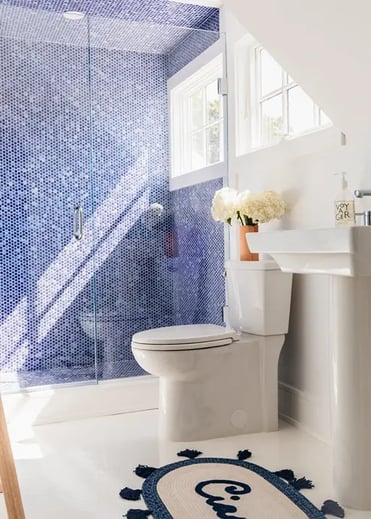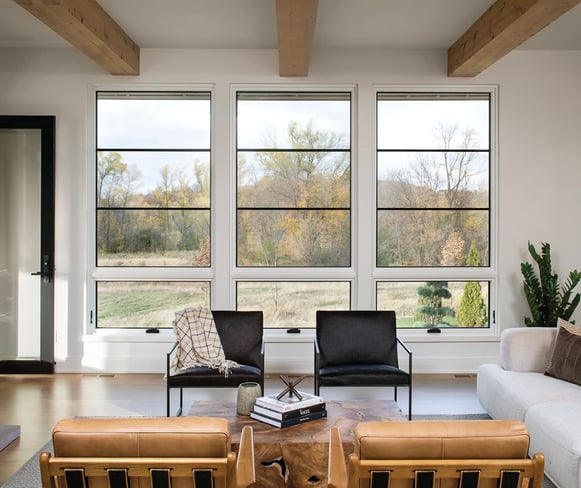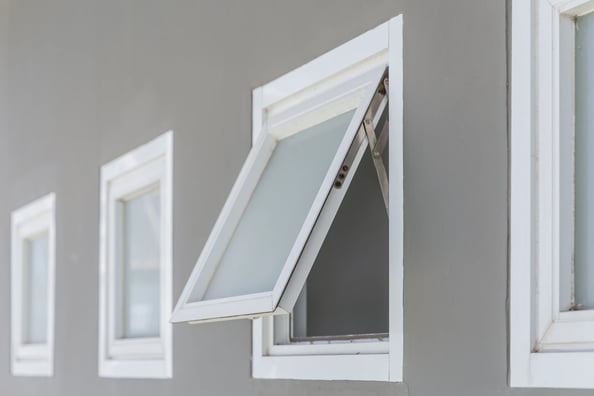If you want a window that brings in the fresh smell of summer rain but doesn't let the water in, an awning window might be just the thing for you.
Awning windows, which open outward and up via a hinge, are a stylish choice that can work in almost any home. In this article, we'll talk about some of their unique benefits as well as the best places to incorporate them into your home.

What Are Awning Windows?

Awning windows are hinged at the top and open outward from the bottom, forming an awning-like effect. This unique design not only provides excellent ventilation but also offers a couple of other benefits.
- Weatherproofing: Let the air in but not the rain! If you love the smell of summer rain, crack open the awning window without worrying about water intrusion.
- Aesthetic Appeal: Awning windows offer a clean and modern look that can complement various architectural styles. Their sleek design and functionality add a touch of elegance to any room.
Related: 15 Types of Windows for Your Home
Where to Place Awning Windows in Your Home
Kitchen
Placement Ideas for Optimal Ventilation and Light Awning windows are perfect for kitchens where you need both natural light and ventilation. Consider placing them above countertops, sinks, or stoves. Their unique design allows you to open them during light rain, ensuring your kitchen stays fresh without letting in moisture.
Design Tips for Integrating Awning Windows in the Kitchen To integrate awning windows seamlessly into your kitchen design match the window frames with your cabinetry or wall colors. Choose finishes that complement your kitchen's overall style, whether it’s modern, rustic, or traditional. Pairing awning windows with fixed windows can also enhance the aesthetic while providing extra light.
Bathroom

Privacy Considerations Bathrooms require windows that provide privacy without sacrificing light and ventilation. Awning windows are an excellent choice as they can be placed higher on the wall, maintaining privacy while still allowing airflow and light.
Benefits of Ventilation in Moisture-Prone Areas Awning windows help prevent mold and mildew by promoting better air circulation in moisture-prone areas like bathrooms. They enable you to keep the windows open even during rainy weather, reducing humidity levels and keeping your bathroom fresh.
Living Room

Enhancing Natural Light and Airflow In the living room, awning windows can enhance natural light and airflow. Position them higher on the walls or above eye level to maximize light without compromising wall space for furniture and decor. Their design ensures that even when it rains, you can enjoy fresh air without worry.
Combining Awning Windows with Other Window Styles for a Unique Look For a unique and stylish look, combine awning windows with other window types such as picture windows or casement windows, like in the picture above, in which picture windows are combined with awning windows underneath.
Basement

Benefits of Awning Windows in Basements Basements benefit greatly from awning windows due to their ability to improve air circulation and bring in natural light, which can make the space feel less confined and more welcoming. Their weather-tight seal also helps keep moisture out, which is crucial for below-ground levels.
Ideas for Increasing Natural Light and Air Circulation Install awning windows near the ceiling of your basement walls to maximize natural light. Pair them with window wells to enhance light entry and create an airy, brighter environment. Awning windows can be a practical solution for ensuring your basement stays dry and well-ventilated.
Awning Window Materials and Styles
Awning windows are available in a variety of materials, each offering unique benefits to suit different needs and preferences.
- Wood: Wood awning windows offer a classic, timeless look that adds warmth and character to any home. They provide excellent insulation but require regular maintenance to protect against moisture and weather damage.
- Vinyl: Vinyl awning windows are a popular choice due to their durability, low maintenance, and affordability. They offer good insulation and are resistant to moisture, making them ideal for areas with high humidity.
- Fiberglass: Fiberglass windows are known for exceptional strength and durability. Like vinyl, fiberglass won't warp or rot, but they last even longer (50 years as opposed to 20-30), can be designed to look just like wood, and can be stained or painted.
Related: Vinyl vs Fiberglass Windows: Cost, Durability, & More
Styles and Finishes
Awning windows come in a range of styles and finishes to complement different architectural designs and personal tastes.
- Contemporary: For a modern look, choose awning windows with clean lines and minimalistic frames. Aluminum and vinyl are popular materials for contemporary styles due to their sleek appearance.
- Traditional: If you prefer classic aesthetic, wooden awning windows with detailed molding and rich finishes can add a touch of elegance to your home. Stain or paint them to match your interior decor.
- Combination: Awning windows can be paired with other window types, such as fixed windows or casement windows, to create a custom look.
Considering a Remodel?
If you're considering a remodel, download our Ultimate Home Remodeling Guide, where we help you budget, pick the right contractor, and prepare for your project. Alternatively, schedule a free consultation withSouthwest Exteriors. We're experts in remodeling, whether you want to add a new awning window or enclose your front porch!

